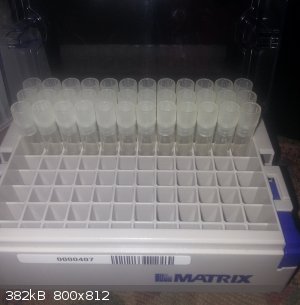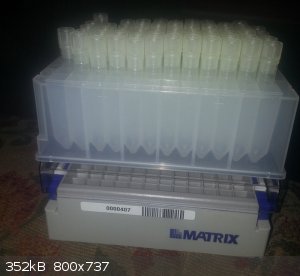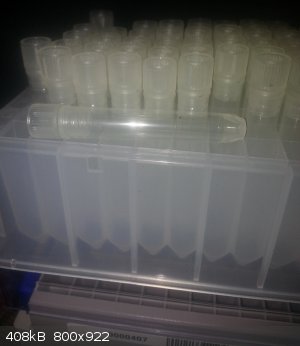| Pages:
1
2 |
aga
Forum Drunkard
    
Posts: 7030
Registered: 25-3-2014
Member Is Offline
|
|
Superb find mayko !
There's hope for us yet !
|
|
|
NEMO-Chemistry
International Hazard
    
Posts: 1559
Registered: 29-5-2016
Location: UK
Member Is Offline
Mood: No Mood
|
|
Considering the diversity of strains gained, the fact some came from things like 2Fistula discharge" (that's nice), and the phage isolated from a pond
and not purchased from a bank.......
You got to ask a simple question, why the hell isnt more money (read huge amounts), being pumped into this? In all honesty if your using knockout
plates, then why not combine several phages that are effective? I honestly thought they were much more highly selective than they appear.
Ok they are highly selective, but I think it shows real promise. But when they are not researching this very much when antibiotics are close to being
shot, then i dont think Olive Trees will be a priority. But seriously aga, wouldnt cost you much to set up and play with some Bovine fetal serum and
bacteria.
Class2 hood, CO2 or similar negative pressure HEPA incubator (pretty cheap second hand on ebay). aga plays with Agar! I can see a series here....
As you have Olives, I would suggest your extremely strict with Bio security and technique, but i dont see why you couldnt do it.
ROSE
Swap you some that sunshine for our high class guaranteed rain if you like 
[Edited on 16-2-2018 by NEMO-Chemistry]
|
|
|
aga
Forum Drunkard
    
Posts: 7030
Registered: 25-3-2014
Member Is Offline
|
|
Unfortunately i'm not young enough to know all about all of this.
Rain would be very helpful.
|
|
|
NEMO-Chemistry
International Hazard
    
Posts: 1559
Registered: 29-5-2016
Location: UK
Member Is Offline
Mood: No Mood
|
|
Quote: Originally posted by aga  | Unfortunately i'm not young enough to know all about all of this.
Rain would be very helpful. |
In your case, the hard bit is finding the phage. The rest is easier than most the chemistry you done.
The reason your best placed is Olives, we can buy Olive Trees in the local supermarket down the road here. But i often wonder why they sell them,
every year we buy some and every winter they die.
Travel
I cant go jumping on planes looking at infected olive groves, thats where I would start. Find the infection and you will find the phage not far from
it.
No guarantee but my logic goes like this.......
Look for a infected Grove, one that isnt totally dead but has been infected a good while. Ideal candidate will have water or boggy bits some parts the
year.
The bacteria needs water, because of how it infects i would think it needs nutrients in good amount and water. As you pointed out sunshine would help
alot. Because if you limit the water your going to deprive the nutrients for the bacteria.
So working backwards, older the site of infection the more chance phages have had time to develop. Most likely place to actually find a phage, and one
the easiest ways to sample.
Is a water swab strait onto lawns of bacteria, or in a perfect world into liquid broth cultures. But if you travel by air then its plates and lawns.
Do enough samples in enough little pockets of water and the odds go your way.
From there there is little to know, ideally you would make the bacteria selective. Take something away from it that only you can then give.
But for that you need to mess with plasmids, so trying to keep it real.
Do without selection, be OCD with ascetic technique, plate the bacteria strains up and liquid culture. The liquid cultures are simply a source of
bacteria for the plate lawns.
Then spot test the plates with the sample swabs, each swab you plate test, put into a tiny liquid culture of the bacteria.
The reason is, if that swab has the phage on, you want to amplify it. easiest way for a non pro is feed it.
If spots on the lawns die rapid, and its obvious you dont have some other bacterial infection killing it, then the chances are good its a phage.
The vial with the feed solution is then upgraded to a larger one, keep it fed and renew every 5 days. This is a candidate.
Ask people to send sample of the xylem from infected trees, actually ask a local uni near the site to grab a sample for you (first/second year work
 ). Test the candidate on the new sample, if that dies........ ). Test the candidate on the new sample, if that dies........
You start to get excited, not free beer excited, but close to it.
This is something you could handle, but needs attention to detail and travel.
Decent scope ~£1,100 second hand
incubator with HEPA filtration, gas and vac line ~£120 -£550 second hand (I got a couple recently that were £50 each). The ones I got recently were
from a uni. Excellent condition and extremely cheap.
Fume hood, you cant/shouldnt make a class2 hood. Secondhand ~£500 - ~£1,500 should do it but get a ducted one, you got Olives so you put a formalin
burner output into the square thing ontop the hood where the ducting connects.
When the hood runs you run the fomalin burner, IF anything gets past the filters, its killed by the fumes. this isnt common as far as I know in a lab.
But labs got the £ to change the filters like socks and I dont.
Plates aga and culture dishes etc ....... £ bit of string - £ long piece of rope.
But 100% someone like you could do this. Infact in many ways your ideal.
Its seriously such a cool project, if I could do the travel and grow.... Actually I could grow olive trees to a certain extent, i could grow cell
cultured ones.
That would give me test sites, your case use cutting and keep them in the lab!! But testing cuttings comes later, alot later.
At the very least aga, you could pass the suspected phage to a uni looking into the disease. They can always take it to the next level.
[Edited on 16-2-2018 by NEMO-Chemistry]
|
|
|
NEMO-Chemistry
International Hazard
    
Posts: 1559
Registered: 29-5-2016
Location: UK
Member Is Offline
Mood: No Mood
|
|
Phages work, they work really well, i cant answer why they are not common as a treatment. I havnt got a clue why this is, same way a guy has millions
killed by words alone. I dont get it, i dont understand the whys, same with phages I dont understand why they seem to be ignored, maybe because where
you tend to find them.
But honestly its always baffled me why not.
|
|
|
Reboot
Hazard to Others
  
Posts: 141
Registered: 8-8-2017
Member Is Offline
Mood: No Mood
|
|
Systemic distribution of a phage would be a huge challenge. They can't really diffuse through membranes, they won't be actively transported, and in
animals the immune system might go crazy when it sees them.
So that's the more profound problem: How do you get the phage to your bacteria?
I think a much more likely strategy would be to target the insect vector (perhaps with something akin to the BT toxins that are engineered into some
crops to kill certain insects.) Otherwise, you're left with the traditional approaches of spraying pesticides or developing a strain of resistant
olive tree.
In the long term, I could imagine immune cells engineered to carry and deliver a phage warhead, although that may not have much advantage over a
normal immune response for most cases.
|
|
|
NEMO-Chemistry
International Hazard
    
Posts: 1559
Registered: 29-5-2016
Location: UK
Member Is Offline
Mood: No Mood
|
|
Quote: Originally posted by Reboot  | Systemic distribution of a phage would be a huge challenge. They can't really diffuse through membranes, they won't be actively transported, and in
animals the immune system might go crazy when it sees them.
So that's the more profound problem: How do you get the phage to your bacteria?
I think a much more likely strategy would be to target the insect vector (perhaps with something akin to the BT toxins that are engineered into some
crops to kill certain insects.) Otherwise, you're left with the traditional approaches of spraying pesticides or developing a strain of resistant
olive tree.
In the long term, I could imagine immune cells engineered to carry and deliver a phage warhead, although that may not have much advantage over a
normal immune response for most cases. |
Why not simply infect the olive trees with the bacteria? Inoculate the bacteria with phage just before infecting.
Or infect day X with bacteria then a few days later spray and infect with bacteria carrying the phage? When the phage has done its bit the rna should
be left to some extent waiting for the bacteria to show up again?
I have done some pics of the matrix system i use, these are what I keep prospects in, as you will see they hold slim 1.3ml tubes. The incubating blocs
have lids and working blocs dont.
Space wise they are a little small than my galaxy note 2 phone, each bloc holds 96 tubes. they also stack, at the moment i have some in the incubator
with test cells from the electroporation experiments.
No idea how many blocs would fit in an incubator, i have had 19 and that hardly took up any room.
Also the vials have screw tops on.
[Edited on 21-2-2018 by NEMO-Chemistry]
[Edited on 21-2-2018 by NEMO-Chemistry]
   
|
|
|
mayko
International Hazard
    
Posts: 1218
Registered: 17-1-2013
Location: Carrboro, NC
Member Is Offline
Mood: anomalous (Euclid class)
|
|
RNA by itself isn't infectious, and is somewhat fragile in ambient conditions.
The infectious unit of a virus is called a virion; it contains the virus genome (which may be DNA or RNA) bundled in a protein shell called a capsid.
Virion stability varies widely.
al-khemie is not a terrorist organization
"Chemicals, chemicals... I need chemicals!" - George Hayduke
"Wubbalubba dub-dub!" - Rick Sanchez
|
|
|
aga
Forum Drunkard
    
Posts: 7030
Registered: 25-3-2014
Member Is Offline
|
|
A good reason for me NOT to experiment would be the serious risk of transmitting the disease from A to B simply because i do not know what i'm doing.
The best location for any research involving the active pathogen will be a biochem university in southern Italy, Naples for example.
I'll see if i can find a contact and email them a link to this thread.
It might be a waste of time, but you never know.
|
|
|
NEMO-Chemistry
International Hazard
    
Posts: 1559
Registered: 29-5-2016
Location: UK
Member Is Offline
Mood: No Mood
|
|
Quote: Originally posted by mayko  | RNA by itself isn't infectious, and is somewhat fragile in ambient conditions.
The infectious unit of a virus is called a virion; it contains the virus genome (which may be DNA or RNA) bundled in a protein shell called a capsid.
Virion stability varies widely. |
Yeah sorry, I was trying to just keep it all really simple. But you understand the principle of what i was saying?
I dont know much about this disease, actually i know nothing about it at all. But on the face of it, why couldnt you use the actual bacteria as the
vector?
Introducing something else to carry the phage isnt a great idea, my own view being this is often the point we seriously get things wrong.
I mentioned a uni lab earlier aga, your right in not doing this in the wild. Nice secure lab with strict bio security. But if you ever get your olives
infected........
|
|
|
NEMO-Chemistry
International Hazard
    
Posts: 1559
Registered: 29-5-2016
Location: UK
Member Is Offline
Mood: No Mood
|
|
Quote: Originally posted by aga  | A good reason for me NOT to experiment would be the serious risk of transmitting the disease from A to B simply because i do not know what i'm doing.
The best location for any research involving the active pathogen will be a biochem university in southern Italy, Naples for example.
I'll see if i can find a contact and email them a link to this thread.
It might be a waste of time, but you never know. |
If you do contact them, can you u2u me the university and email address you used please?
|
|
|
j_sum1
|
Thread Split
23-1-2019 at 17:46 |
pneumatician
Hazard to Others
  
Posts: 414
Registered: 27-5-2013
Location: Magonia
Member Is Offline
Mood: ■■■■■■■■■■ INRI ■■■■■■■■■■ ** Igne Natura Renovatur Integra **
|
|
well I think I've a passive method to save the olive trees, if you have 1 million € free of taxes contact me 
also if you want to produce megalots of lemons in bare sand...
the method is so simple...
|
|
|
mayko
International Hazard
    
Posts: 1218
Registered: 17-1-2013
Location: Carrboro, NC
Member Is Offline
Mood: anomalous (Euclid class)
|
|
ooops! turns out this isn't necessarily true!
https://en.wikipedia.org/wiki/Viroid
al-khemie is not a terrorist organization
"Chemicals, chemicals... I need chemicals!" - George Hayduke
"Wubbalubba dub-dub!" - Rick Sanchez
|
|
|
Neal
Hazard to Others
  
Posts: 156
Registered: 24-12-2021
Location: Chicago, IL, USA.
Member Is Offline
|
|
Some various quotes from this thread:
| Quote: | | My initial thoughts are about a magnesium compound that could at least be tolerated by the plant, yet be toxic to the bacterium.
|
| Quote: | | I'd start with boric acid as it kills veroa mites (for the bees) |
For elemental metals, copper is the only anti-bacterial by a long shot.
But for plants selectivity, use 3% hydrogen peroxide, kills bacteria and such with minimal harm to plants.
|
|
|
karlos³
International Hazard
    
Posts: 1520
Registered: 10-1-2011
Location: yes!
Member Is Offline
Mood: oxazolidinic 8)
|
|
Silver?
verrückt und wissenschaftlich
|
|
|
Tsjerk
International Hazard
    
Posts: 3035
Registered: 20-4-2005
Location: Netherlands
Member Is Offline
Mood: Mood
|
|
Quote: Originally posted by Neal  | Some various quotes from this thread:
| Quote: | | My initial thoughts are about a magnesium compound that could at least be tolerated by the plant, yet be toxic to the bacterium.
|
| Quote: | | I'd start with boric acid as it kills veroa mites (for the bees) |
For elemental metals, copper is the only anti-bacterial by a long shot.
But for plants selectivity, use 3% hydrogen peroxide, kills bacteria and such with minimal harm to plants. |
The bacteria live inside either the phloem or the xylem, I didn't bother to check which, but good luck injecting peroxide in there, let alone having a
plant survive it.
I think the best chance at having a shot at these bacteria is by attacking them with bacterial phages. But how do you get those at the bastards?
Plants don't really allow anything bigger than molecules into the areas where these bacteria live, and there is no continuous flowing system in plants
to inject something into.
[Edited on 29-12-2021 by Tsjerk]
|
|
|
| Pages:
1
2 |